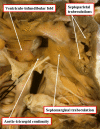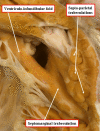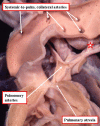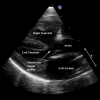Tetralogy of Fallot
- PMID: 19144126
- PMCID: PMC2651859
- DOI: 10.1186/1750-1172-4-2
Tetralogy of Fallot
Abstract
Tetralogy of Fallot is a congenital cardiac malformation that consists of an interventricular communication, also known as a ventricular septal defect, obstruction of the right ventricular outflow tract, override of the ventricular septum by the aortic root, and right ventricular hypertrophy. This combination of lesions occurs in 3 of every 10,000 live births, and accounts for 7-10% of all congenital cardiac malformations. Patients nowadays usually present as neonates, with cyanosis of varying intensity based on the degree of obstruction to flow of blood to the lungs. The aetiology is multifactorial, but reported associations include untreated maternal diabetes, phenylketonuria, and intake of retinoic acid. Associated chromosomal anomalies can include trisomies 21, 18, and 13, but recent experience points to the much more frequent association of microdeletions of chromosome 22. The risk of recurrence in families is 3%. Useful diagnostic tests are the chest radiograph, electrocardiogram, and echocardiogram. The echocardiogram establishes the definitive diagnosis, and usually provides sufficient information for planning of treatment, which is surgical. Approximately half of patients are now diagnosed antenatally. Differential diagnosis includes primary pulmonary causes of cyanosis, along with other cyanotic heart lesions, such as critical pulmonary stenosis and transposed arterial trunks. Neonates who present with ductal-dependent flow to the lungs will receive prostaglandins to maintain ductal patency until surgical intervention is performed. Initial intervention may be palliative, such as surgical creation of a systemic-to-pulmonary arterial shunt, but the trend in centres of excellence is increasingly towards neonatal complete repair. Centres that undertake neonatal palliation will perform the complete repair at the age of 4 to 6 months. Follow-up in patients born 30 years ago shows a rate of survival greater than 85%. Chronic issues that now face such adults include pulmonary regurgitation, recurrence of pulmonary stenosis, and ventricular arrhythmias. As the strategies for surgical and medical management have progressed, the morbidity and mortality of those born with tetralogy of Fallot in the current era is expected to be significantly improved.
Figures









References
-
- Fallot ELA. Contribution a l'anatomie pathologique de la maladie bleu (cyanose cardiaque) Marseille Medical. pp. 77–93. - PubMed
-
- Perry LW, Neill CA, Ferencz C, EUROCAT Working Party on. Congenital Heart Disease . Perspective in Pediatric Cardiology Epidemiology of congenital heart disease, the Baltimore-Washington Infant Study 1981–89. Armonk, NY: Futura; 1993. pp. 33–62.
-
- Oppenheimer-Dekker A, Bartelings MM, Wenink ACG. Anomalous architecture of the ventricles in hearts with overriding of aortic valve and a perimembranous ventricular septal defect ("Eisenmenger VSD") International Journal of Cardiology. 1989;9:341–355. doi: 10.1016/0167-5273(85)90032-4. - DOI - PubMed
Publication types
MeSH terms
LinkOut - more resources
Full Text Sources
Research Materials

